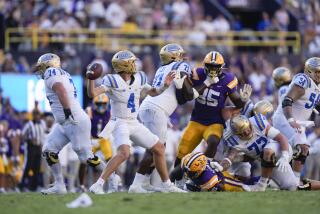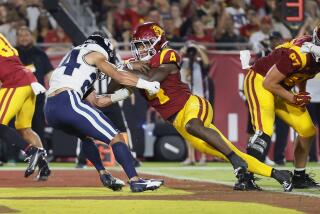ANALYSIS : Collapse of CSUN Began With Attitude : College football: Expecting to lose early games set the tone for Matadors’ dismal 1-4 showing in WFC.
In the distance, the Cal State Northridge marching band played the final notes of the school song. As the familiar strains died off, a few weary players emerged from the visitors’ locker room at Cal State Sacramento.
Moments earlier, the Matadors had absorbed a season-ending 55-12 loss, but these players were not ready to take off their uniforms for the last time.
Ken Vaughn, Northridge’s All-Western Football Conference linebacker, seemed to speak for the obviously frustrated group when he said, “I hope the juniors learn from our mistakes.”
Vaughn, the school’s career leader in tackles, is a senior. He was out of chances. And out of answers.
It was the fourth consecutive lopsided loss for Northridge (3-7, 1-4 in the WFC), yet it still came as a shock to some of the players who started the season with playoff aspirations on a team that was ranked 15th in Division II.
The mystifying collapse of what once was the Western Football Conference’s best defense and the injuries and illness that limited junior quarterback Marty Fisher to less than five quarters in the last four games hurt the team the most.
But the Matadors’ demise probably started much earlier, in games against Eastern Washington, Eastern New Mexico, Cal State Fullerton and Central Oklahoma.
Two of the losses in that stretch--to Division I-AA Eastern Washington and Division I Fullerton (the Titans’ only win of the season)--might have been too easily accepted by many of the Northridge players. The Matadors used their Division II status as an excuse even though they probably were more talented than either opponent.
The eight players who met the press after the game in Cheney, Wash., barely seemed disappointed and, with the exception of senior cornerback Tremelle Barnes, none of the players who spoke to the press after the Fullerton game seemed upset at all. In fact, most of the players greeted their families and friends as they left the field, lingering for several minutes while the CSUN coaching staff attempted--in vain in some cases--to round them up for a postgame meeting.
Obviously, nothing is wrong with thanking loved ones for attending a game or even putting on a smile for them after a loss. The problem was that Northridge expected to lose.
Even in their two early wins, the Matadors played poorly. They escaped against Eastern New Mexico because of a missed field goal, and the impetus in their 9-7 win over Central Oklahoma was a halftime scolding by Coach Bob Burt.
The only time the offense and defense played well at the same time was in a 45-27 victory over Santa Clara. In retrospect, it might have been more an indication of the shortcomings of Santa Clara, which finished 0-5 in the WFC, than of Northridge’s prowess.
From the outset, injuries and academic problems took their toll. Defensive back Keith Washington (broken arm) and offensive linemen Matt Nicolo (knee injury) were sidelined before the season and cornerback Eric Barnes and offensive tackle John Chase were declared academically ineligible.
The loss of Washington and Barnes forced Burt to start redshirt freshman Vincent Johnson at cornerback, and several opponents took advantage. The offensive line never developed because of injuries to Jack Montes, Skip Allum, Kevin Bess and George Fua.
The quarterback and fullback positions also were injury-plagued. Along with the broken leg suffered by Fisher, backup quarterback Coley Kyman incurred a season-ending broken collarbone in the second game, and Albert Razo, the punter and a reserve quarterback, missed the last three games because of a severely sprained ankle.
With yet another quarterback, freshman Bradley Freeman, sidelined by a broken collarbone, Northridge did not have a scout-team quarterback for the last two weeks of the season.
Fullback Anthony Nicholson was hobbled by a sprained ankle all season. His backup, Jim Warren, missed the first five games while recovering from arthroscopic knee surgery.
Another factor was the schedule--seven of 10 games were on the road, including the first three. Yet in those three games the CSUN defense made 11 of its 15 interceptions and allowed less than 250 yards per game. In its last five games, Northridge gave up an average of more than 400 yards.
“We had high hopes because we had very talented people on this team . . . great defensive players, scorers, a lot of all-conference players,” senior wide receiver Cornell Ward said. “We just didn’t pull it together.”
Burt, who had not experienced a losing season in his first five seasons at Northridge, is convinced that 1992 will be different.
“I want every one of our underclassmen to remember 56 and 55,” Burt said, referring to the point totals amassed by Southern Utah in a 56-28 pasting and Sacramento in a 55-12 setback. “Because I’m not going to forget.”
More to Read
Go beyond the scoreboard
Get the latest on L.A.'s teams in the daily Sports Report newsletter.
You may occasionally receive promotional content from the Los Angeles Times.










